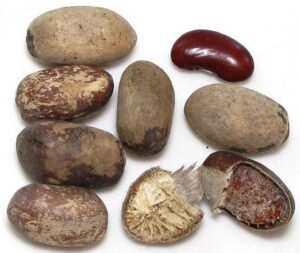Ede Mberi, a local dish that is rich in nutrition and culture
Showcasing a Nigerian dish that is native to people in the Eastern part of the country.

By Blessed Ihekwoaba
Cocoyam is a well-known delicacy in many parts of Africa, and it is enjoyed by people of all ages. However, the people of Uzii, a town located in Ideato North Local Government Area of Imo state, have a strange way of making a mouth-watering dish out of cocoyam species that are almost inedible. The dish is popularly called “Ede mberi” or cocoyam porridge among the natives of the town. It is highly valuable not only for its taste but also for its many nutritional benefits.
In this article, we will explore the origins of this unusual treat, its nutritional value, and how to prepare it. Trust me you want to try this dish. The history of cocoyam in the locality is not recorded, but Uzi is endowed with a range of species of cocoyam, which they consumed in various ways, some are boiled and eaten with palm oil, another is boiled for some days and pounded to look like amala and eaten with soup. The cuisine is created from a kind of cocoyam that is not eaten boiled with red oil as it will make your throat sore. However, the people discovered a way to make lemonade out of lemons, illustrating the inventive spirit of the locals.
It is a dish that is highly beneficial for one’s health as one ages, which is why it is often made for elderly people. The dish with the most nutritional value, cocoyam, contains significant amounts of vitamins, minerals, and protein.
Did you know? It provides the same nutrition as all six food groups and tremendous health benefits.
Credit: Meiza Nigeria
Cocoyam contains more calories than potatoes. There are 112 calories in 100g. It has no gluten and gets most of its calories from amylose and amylopectin, two types of complex carbohydrates. They have excellent phytonutrient profiles with dietary fibre and antioxidants. Cocoyam is also helpful for treating rheumatoid arthritis (RA) symptoms because low vitamin B6 levels are linked to increased RA symptoms, such as more intense pain. Potassium, another key element that is necessary to be healthy and effective, is present in significant amounts in cocoyam. Potassium helps to reduce strain and tension on blood vessels and arteries and facilitates proper fluid exchanges between membranes and tissues throughout the body. Due to the high amount of Vitamin C it contains, cocoyam is significant for the immune system.
Calabash nutmeg, also known as ehuru, ehu, ariwo, or nutmeg of the calabash, a vital ingredient for the dish; has been used for generations by certain tribes to cure a variety of illnesses. It can be added to the dish to enhance its flavour and provide additional health benefits, such as pain management, sleep induction, and fever reduction. The African oil bean seed in the dish; in a serving size of 100 grams (raw), has 617.44 calories, 14.978 grams of protein, 48.916 grams of fat, and 28.336 grams of carbohydrates.

According to locals, it is a dish that takes time to prepare. To prepare this delectable dinner, you need the following ingredients: cocoyam, seasoning cubes, pepper, red oil, ugba (oil bean), ehuru, ehu, Ariwo, or calabash nutmeg seeds, and some uziza seeds.
Here are the steps to prepare cocoyam:
Step 1: Put some water in your pot and light it on fire.
Step 2: Put the particular kind of cocoyam in the saucepan after washing.
Step 3: Take the back off after bringing it to a boil for 15 minutes.
Step 4: Replenish the water in the pot, then add the cocoyam.
Step 5: Cook until all of the water has evaporated. Keep till the next day.
Step 6: Cook the cocoyam until it dries up once more, then add more water till it is just above
the cocoyam.
Step 7: On the third day, add water until it is once again just over the cocoyam and continue
cooking until it is dry.
Here are the steps to mix the dish:
Step 1: Ehu and Uziza nuts should be well-ground before adding red oil, salt, pepper,seasoning cubes,
and oil beans. Blend well.
Step 2: Now stir in your chilled cocoyam completely.
Step 3: Scoop it into the saucepan, heat it, mix it as it cooks, and then serve it hot and enjoy!





![For some, the allure of Ibadan’s amala joints lies in the tastefulness, which influences them to travel long distances to savour the food. [Instagram - amala_central]](http://meiza.ng/wp-content/uploads/2024/02/For-some-the-allure-of-Ibadans-amala-joints-lies-in-the-tastefulness-which-influences-them-to-travel-long-distances-to-savour-the-food.-Instagram-amala_central--e1709034076351-390x220.jpg)

